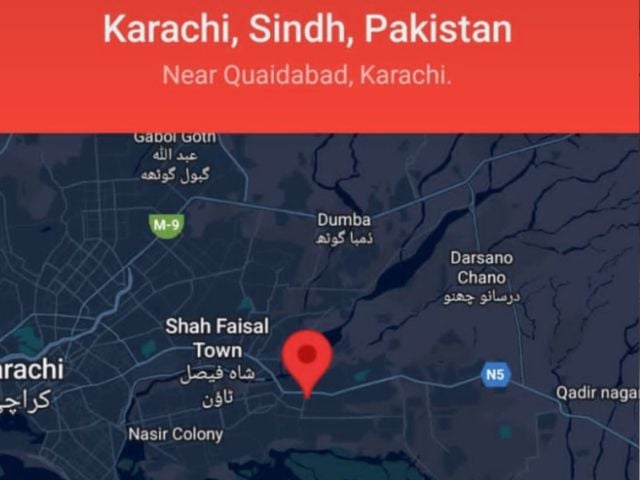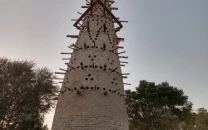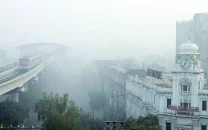Karachi shaken by two more earthquakes as six-day tremor tally hits 32
Karachi has been experiencing low-intensity earthquakes across various localities

Karachi was shaken again on Friday morning by two earthquakes, bringing the total number of tremors in six days to 32.
According to Express News, the first quake’s epicentre was in DHA, while the second originated in the Malir district.
Earlier last night, residents in Bhains Colony and surrounding areas also felt tremors, causing widespread panic. Many residents rushed out of their homes, reciting the Kalma.
Since Sunday, Karachi has witnessed multiple low-intensity earthquakes across various localities, escalating concerns among the populace.
The National Tsunami Centre director at the Meteorological Department, Ameer Haider Laghari, has warned that the Landhi fault line is expected to remain active for the coming days.
He explained that movements in underground tectonic layers are generating energy gradually being released, resulting in these recurring earthquakes.
Earlier, according to the National Tsunami Center (Pakistan Meteorological Department), these tremors are not a warning sign of a major natural disaster, but rather a natural geological process. This activity may help balance the local fault line for years to come.
Ameer Haider Laghari, head of the National Tsunami Center, explained that the Quaidabad fault line remains active, and the situation could continue for up to a week.

The year’s first earthquake in Karachi was recorded on March 31, registering 4.7 magnitude with a depth of 19 kilometers. In contrast, this latest sequence has shown a consistent pattern, specifically in Malir and Quaidabad, where nine low- to moderate-intensity earthquakes occurred within two days. Several parts of the city felt the tremors.
In an interview with Express News, Ameer Haider Laghari noted that the quakes stem from natural tectonic shifts, where built-up energy in the earth is gradually released, causing seismic activity. He emphasized that this is a global geological process, occurring in some regions more frequently than others.
He recalled similar tremors in northern Pakistan, where activation of a fault line triggered panic in Islamabad and nearby areas for several days.
READ MORE: 4.6-magnitude quake jolts northwestern Pakistan
Laghari assured that the Karachi earthquakes are low-intensity, and each subsequent tremor has been less intense than the previous one. He also clarified that these are not aftershocks, as such minor quakes don’t usually produce aftershocks—they are independent seismic events.
He warned that Malir, Quaidabad, and surrounding areas may continue to feel tremors for two more days to a week. Pakistan lies in a shallow earthquake zone, meaning most quakes occur at low depths.
He also highlighted other active fault lines in the region, including the Landhi fault line, Thana Bula Khan, and the Western Kirthar Range Plate Foundry Fault Line.
As a precaution, he advised that residents of structurally weak buildings should evacuate quickly during tremors. People should avoid standing near walls and instead, seek open spaces for temporary shelter.
Providing a broader context, Dr. Adnan Khan, Associate Professor and Geologist at the University of Karachi, told Express Tribune that these were minor tremors and not a cause for alarm.
He explained that Karachi is situated on a passive tectonic margin, far from any major fault line, making large, destructive earthquakes highly unlikely in the region.
“These tremors are classified as mild, resulting from minor tectonic movements and stress accumulation deep within the Earth's crust,” Dr. Khan stated.
READ MORE: 3.6 magnitude quake jolts Quetta
He also linked these movements indirectly to Himalayan tectonic activity, where the northward shift of the mountain range, by 4 to 5 cm annually, can generate distant tectonic pressures, occasionally manifesting as low-intensity quakes even in far-off areas like Karachi.
Dr. Khan further pointed to human factors that may play a subtle role in altering subterranean stability, including industrial waste incineration and excessive groundwater extraction, both of which can influence local seismic behavior over time.
While the scientific consensus remains that these tremors are harmless, both Laghari and Dr.Khan stressed the importance of basic safety awareness.
Dr. Khan also advised citizens to remain calm during any such tremor and to immediately move to open areas, staying away from walls, foundations, or tall structures.





















COMMENTS
Comments are moderated and generally will be posted if they are on-topic and not abusive.
For more information, please see our Comments FAQ